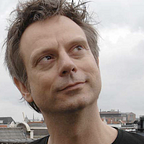Waved notes on Design by Fire
Today I attended the Design by Fire conference. For me it was the first time, I heard a lot of good stories from last years edition and always like to see Matt Jones of course. It was a pleasant day with nice people and some good talks. Where especially Matt Jones delivers to my expectations with a great talk on the element of time in good experience design.
During the conference I also did an interesting experiment in taking the notes using Google Wave together with Taco Ekkel. For me it was the real first functional use of Wave, and it surely was promising. And it connects wonderful with the leading theme of the day for me; designing for real-timing experiences.
I will not do a full report on the talks. If you have a Wave-account, let me know; I share the wave with you. I think it more interesting to look to important things that were said, or were left behind.
The opening keynote of Robert Hoekman was in my opinion an example where more was left out than said. His lecture on pattern platforms and design patterns did not address the real design issues. Creating comfortable experiences by using emerging structures is just the start of a good and effective design. The real value will be in the extra experience you create on top of it. The emphasis of Matt to look for the flow between irritation and boredom is the real challenge. The science of patterns could be seen as the necessary fundament and enabler of the freedom to design the real experiences.
Marcel Kampman and Ronald Mannak and especially Alrik Koudenburg showed us the way you add more to the comfortable design by telling real stories and make it possible to experience them: “If we get comfortable with being uncomfortable, we can deliver the best of ourselves.”
It is easy to connect this view to the analysis of the guys from Clearleft (James Box & Cennyd Bowles) did earlier on the analogy between the music experience and the design experience. They manage to prove the resemblance, but leave the consequences for our own imagination. If you think on the influence sound can have on our moods it is good to think on the way we can avoid the noice in user experiences. And here also the insight that comfortable music is also not the way we will get happy. Then you will get the muzak of Richard Glidermann…
The necessary next step to think about is the way we create those satisfying frictions in real time experiences. The last two speakers dealt with this. As Tom Jerkins showed in the examples of the design for the mobile user experiences is the way the tangible context is part of it. Creating physical prototypes is the only way to value the design. Start with the real use, show the experiences and tell stories.
Matt Jones added the aspect of time, creating real-time products. Time is a material for interaction design. The more monochronic time (M-Time) which is used to build a experience by adding emerging history. And the polychronic time (P-Time) where time is a relative quality of an experience. Like real-time streams in Twitter. The quest for the ultimate real-time products (or impulse services like I called them before) is just starting now; we need to find new paradigms without a ‘red dot fever’.
Google Wave is of course dealing with some of these aspects. Matt used Wave in his presentation to address a current problem with designing these kind of products: do we have already the mental models to profit from real-time concepts. Something that emerges with the use of Wave as collaborative note-making tool. It works great for working together, but it became fuzzy when we added a backchannel function for wavers that were not at the conference. Shifting real-time on different using levels is still a challenge.
